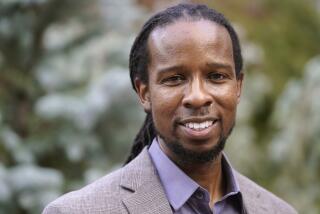A Word of Caution for Men
- Share via
Like many men, Bill Kenny wasn’t aware of the need to do a monthly self-exam to detect testicular cancer in its early stages. Then came the day, seven years ago, when Kenny couldn’t ignore the swelling in his left testicle.
“I never expected to hear the word ‘cancer,’ ” says Kenny, a Los Angeles television writer. So dire was the situation that he had surgery to remove the testicle the next day, followed by radiation treatment. Three years later, his right testicle was found to be cancerous. He had it removed and underwent chemotherapy.
Today, Kenny, 37, is cancer-free--and spreads the word whenever possible about the value of early detection.
This year, 7,400 men in the United States will learn that they have testicular cancer and 370 will die, according to estimates from the American Cancer Society.
From 1973 to 1992, the incidence of testicular cancer increased about 45%. But in recent years it may be leveling off, according to the National Cancer Institute. While still a rare cancer, it is the most likely type to affect men 15 to 35, according to the American Cancer Society.
The disease has been in the news recently. Cyclist Lance Armstrong; baseball players John Kruk, who has retired, and Mike Gallego; and track star Steve Scott have gone public with their battles.
The publicity might persuade men to pay more attention, experts hope. When caught in early stages, testicular cancer is curable in more than 95% of cases, the American Cancer Society says. But if it has spread, it can be devastating, even fatal.
At higher risk for the disease are men who have an undescended testis along with those whose brother or other family members have had the cancer. The incidence of testicular cancer in men whose mothers took the hormone DES to prevent miscarriage is under study.
One of the best ways to catch the cancer early is to perform a simple, 3-minute monthly exam. It is best done, the American Cancer Society says, after a warm bath or shower, when the scrotal skin is most relaxed. Roll each testicle gently between the thumb and fingers of both hands. A small hard mass about the size of a pea on the front or side of the testicle is a common symptom. If any hard lumps or nodules are detected, see a doctor.
Enlargement of one of the testes and a change in consistency are other common signs of testicular cancer. Pain may be absent, but there may be a dull ache in the groin area.
Men are especially good at ignoring or brushing off these symptoms, says Dr. Timothy Wilson, a urologic oncologist and director of urology at the City of Hope National Medical Center in Duarte. “They attribute [irregularities] to something else,” he says. “They figure they bumped themselves. Or they say they were extra vigorous during sex.”
If testicular cancer is suspected, a physician performs a physical exam and relies on biopsy and other tests to confirm the diagnosis, including blood tests to detect certain proteins produced by testicular cancers. Ultrasound studies can evaluate whether the disease has spread.
“We take a chest X-ray to be sure it hasn’t spread to the lungs,” Wilson says.
Treatment is guided by the type of testicular cancer and its stage. Surgical removal of a testis, or orchiectomy, is the first step. Removal of the surrounding lymph nodes is sometimes needed. Radiation therapy or chemotherapy are sometimes necessary too.
Recovery from orchiectomy generally takes one or two weeks, Wilson says. If lymph node removal is needed, recovery can take up to three months.
The risk of recurrence is highest in the first two years after treatment, the American Cancer Society says, and patients should be followed closely during this time. If a man is three years disease-free, it is “tantamount to cure,” the society says.
Chemotherapy can damage testicular function and cause infertility. Sperm banking is often offered to chemotherapy patients beforehand.
The surgery, Wilson tells patients, “has no physical effect on the sex drive,” although the psychological effects of the cancer may lead to diminished sexual desire.
In the past, some who underwent testicle removal opted for a testicular prosthesis, saying it helps improve body image. But such prostheses are not approved for marketing, says Sharon Snider, a spokeswoman for the Food and Drug Administration. Mentor Corp. in Santa Barbara hopes to begin a clinical study of a saline-filled testicular implant, a representative says.
Meanwhile, Kenny, a two-time survivor of testicular cancer, says nothing should dissuade men from seeking help if they suspect testicular cancer. Not even machismo. While many men are simply unaware of the threat of testicular cancer, others are repelled by the idea of having it, Kenny has found.
When they hear his story, some men have told him: “I’d rather die than lose a testicle.”
(BEGIN TEXT OF INFOBOX / INFOGRAPHIC)
They Can Help
For more information on testicular cancer:
* The Wellness Community, based in Santa Monica, is a nonprofit organization that provides psychological and emotional support to cancer patients and their families; (310) 314-2570.
* American Cancer Society; (800) ACS-2345.






